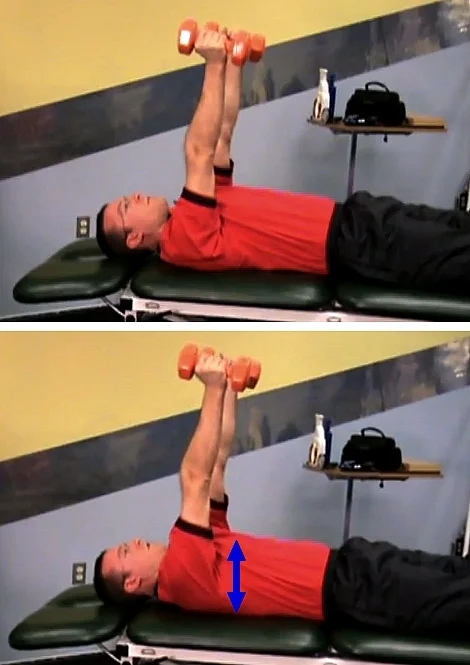Rotator Cuff Tendinitis Exercises to Relieve Shoulder Pain
Shoulder pain, that develops gradually, rather than via a fall or obvious injury may be treated at home through rehabilitation and shoulder strengthening exercise routine. If you have severe and persistent pain and/or you have suffered an injury you should consult a doctor an get professional advice. This also applies if the exercises cause anything beyond mild pain and the condition fails to respond to home exercise programs.
The most common shoulder pain located in the front of the shoulder, or pain that occurs when lifting or grabbing things above shoulder height is due to problems with the Rotator Cuff. Common symptoms of rotator cuff injury or strain are pain and difficulty raising the arm. It is painful for many people to lie on the shoulder when in bed, and many waking up at night with pain in the shoulder.
It is painful for some people to attempt and reach behind their backs. Reaching outward and upward can be painful and some feel a lack of strength when attempting to lift objects. The pain may also be associated with degeneration or inflammation of the Rotator cuff tendons leading to Rotator Cuff Tendinitis and what is called 'Shoulder Impingement Syndrome', which is caused by repetitive arm movements or long periods with the arm in the one position such as prolonged mouse and keyboard use on computers that irritates and inflames the shoulder bursa. The Bursa are the lubricated bag-like tissues that act to minimize friction and help protect the muscles and tendons when they move against each other.
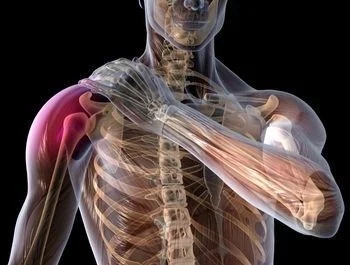
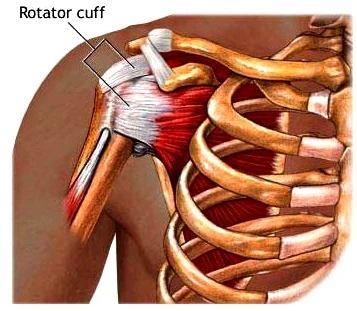
The aim of this article is to explain these common causes of shoulder pain and home remedies and exercises that can be used to treat them.
The rotator cuff is a set of tendons, which surround the head of the humerus (the upper arm bone) to hold it secure in the socket and help the shoulder joint function properly. The rotator muscles and tendons help the arm to rotate at the shoulder joint and to provide a full range of movement.
The rotator cuff can be injured with a fall onto the arm or by jerking a load over head, or when the arm is pulled downward. Injuries to the rotator cuff can cause a tear that may require surgical treatment as they don't heal readily.
The rotator cuff can also degenerate slightly with age or repetitive use. The pain of Shoulder Impingement Syndrome is due to a pinching action or a rubbing (an impingement) by the tendons causing irritation to the shoulder bursa. People who work a lot with their arms overhead, poor posture and various athletes who use repetitive throwing motions, swimming and tennis, can cause inflammation of the shoulder tendons and bursa. Poor alignment of the shoulder joint can restrict arm movement arm and decrease circulation.
Symptoms of this type of shoulder pain, typically occurring in the front of the shoulder area, are a sharp pain when you lift your arm to front or the side of your body, pain and/or general soreness that developed after repetitive movement or prolonged computer activity and shoulder pain when trying to sleep, especially when lying on the sore shoulder.
People at risk for this affliction include athletes involved in throwing and racket sports such as tennis players, baseball pitchers, swimmers as well as people who use their computers for long periods who repetitively reach forward to move their mouse or to type on their keyboard. People who have poor posture when at the computer (such sitting with rounded shoulders or lower arms not parallel with the desk, and who don't support their wrists may pinch one or more of the tendons in the shoulder region) run the risk of developing these problems especially in old age. Anyone who reaches over head frequently and regularly can develop this problem. This includes swimmers, waiters, window cleaners, painters.
Common Causes of Rotator Cuff Tendinitis (Impingement Syndrome) are:
- Maintaining your arm in a fixed position for prolonged time periods, such as working on computers, office work or hairstyling, especially with poor posture.
- Sleeping on the same arm or shoulder each night
- Playing sports that require the arm to be raised above head-height repeatedly such as tennis, swimming,baseball (particularly pitching) and lifting heavy weights above your head.
- Job that require activities requiring the arm to be held overhead for many hours a day (such carpenters, glazers, interior decorators and painters)
- Degeneration, lack of stretching, lack of exercise, or poor control of your shoulder and shoulder blade tendons and muscles.
- Poor posture and non-ergonomic seating positions, may over many years cause degeneration or fraying of the tendons that develops into rotator cuff tendinitis, or even tears.
Ways to Prevent Shoulder Pain includes:
- adopting proper postures and using ergonomic workstation designs,
- practising proper postures when working at desks and when using computers.
- doing exercises to strengthen and regularly stretch the muscles of the shoulders and scapular
- taking regular breaks from computer work and regular stretching exercises when working.
- anti-inflammatory drugs.
Self Treatment Strategies
If you have developed shoulder pain that matches these symptoms and is relatively mild and not long lived, it is worth trying some simple treatments at home
- rest
- strengthening and stretching exercises for the neck, shoulders and back
- installing ergonomic workstation devices and aids and getting advice on posture
- minimizing or avoiding overhead activities at least for a week or more until the pain declines,
- applying ice for 10-16 minute intervals for about 3-6 times per day
- massaging the area to alleviate pain.
- specific rehabilitative exercises recommended by a doctor.
- professional massage therapy and chiropractic manipulation and professional physiotherapy for restoring muscular balance and flexibility.
Limiting Lifting Activities until you Recover - Try to eliminate or reduce lifting and over head reaching until the symptoms decline. Avoid over-the-head grabs, reaching over the chest, lifting with arms out stretched, sleeping directly on the shoulder and leaning on the elbows. Ways to reduce the strain include:
- Only lift objects with your arms held close to the body
- Only lift lighter weights and not overhead
- Do breaststroke or sidestroke when swimming
- Throw balls sidearm or underhand
- Only serve overhand in tennis or volleyball using a slow action or serve underarm
- Get advice and change your posture when doing office work, assembly work, writing, or when using a computers at home or work.
- If the pain continues or there is any swelling in the injured tendons you should consult a doctor.
With rest, change in posture, stretching and exercises, the symptoms often improve or go away in many people that have mild problems. However, this may take weeks or months to occur.
There are a range of stretching and exercises for the shoulder and scapular that provide help for many people.
Stretching Exercises
Stretching (range-of-motion) exercises are the best strategy at the start of the recovery period. Doing these exercises is aimed at maintain shoulder joint flexibility and mobility. You should only feel mild pain with these exercises. If you feel sharp or stabbing pain while stretching or exercising, stop the program immediately and consult a doctor.
The Pendulum Stretch - This exercise gently stretches the tendon area and relieves pressure on the tendons. It can be done at home or work to relieve strain. Gently bend over with your arm hanging vertically. Start the stretching with the arm only for the first few days, then use weights of 1 to 2 lb (0.5 to 1 kg) each week and gradually expand the diameter of the movement circle. You can use a bottle of water. Swing your arm back and forth or in a small circle (no greater than 12 in (30 cm) in diameter). The exercise may cause mild pain or strain but this is OK if not severe.
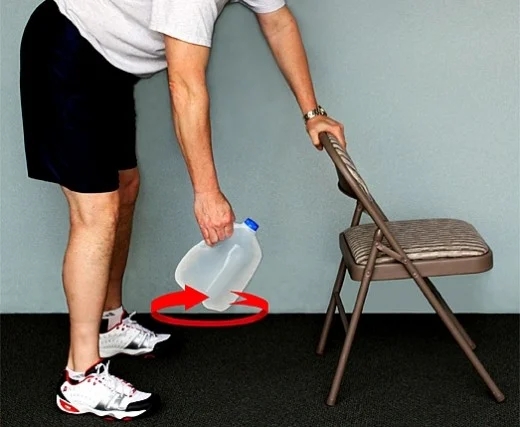
Muscle Strengthening Exercises - These exercises improve shoulder muscle strength, relieve pain when done gently, and help to prevent further injury or problems. The level of resistance or weight size can be increased gradually. Some Mild soreness is OK with these exercises, but stop them if sharp or severe pain occurs. Perform 15 to 20 repetitions of each exercise described fairly slowly to avoid strain and jerking, holding for one to two seconds at full extension for each exercise. You can use hand weights or resistance bands for these exercises.
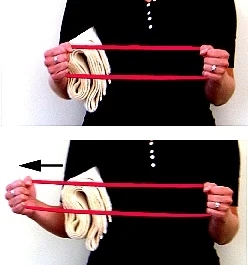
Outward Rotation Exercise - Hold your arms bent 90 degrees at the elbows, close to your sides. You can use towel between your body and your upper arm it keep it by your side. Swing the affected forearm outward away from your body for about 3 inches or 10 cm, holding for about 5 seconds
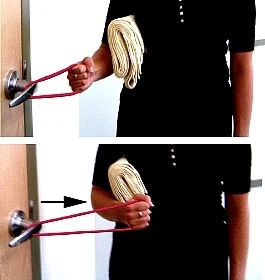
Inward Rotation Exercise - This is similar with the band attached to a door handle or something similar.
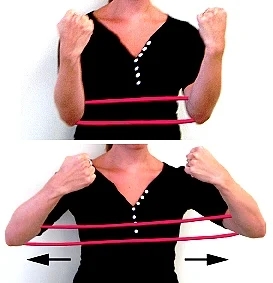
Arm Lifting Exercise - Using both arms, bend your arms at the elbow with the resistance band near each elbows and extend your arms out 4-5 inches ( 3 cm) away from your body, holding for about 5 seconds.
External Rotation in Prone Position - Lie on side with your elbow resting on stomach. Slowly rotate arm upwards until your lower arm is just above horizontal. This exercise can be initiated using a 2-3 pound dumbbell.
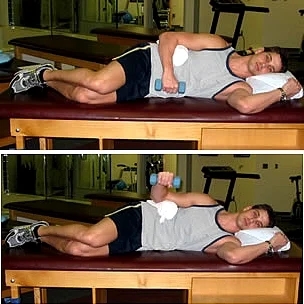
Horizontal Abduction in Prone Position - Lie on stomach with your arm hanging down vertically with your thumb facing forward. Slowly lift your arm up to the horizontal position side ( not higher as it will cause strain).
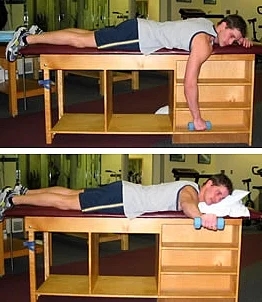
Prone Forward Elevation in Prone Position - Lie on stomach with your arm hanging down vertically, but with your thumb facing forward. Slowly raise arm in a forward sweep to an angle of about 45 degrees (don't go any higher).
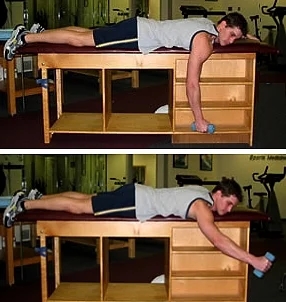
Prone Rowing Action - Begin in the same setup as before but with your thumb is facing towards the body. Perform a rowing action with the elbow level with the shoulder as shown.
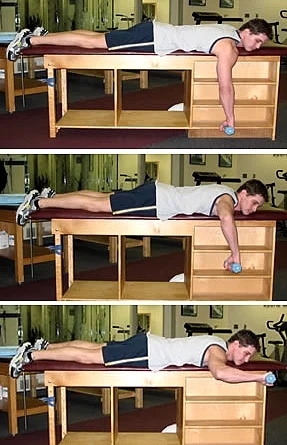
External Rotation with Resistance Band - Take a position holding the band across your abdomen, with a rolled towel under your arm. Slowly rotate arm horizontally until it is pointing forward, and hold for 3 seconds.
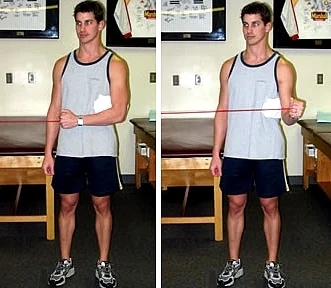
Horizontal Abduction with Resistance Band - Face the attachment pint for the band, with hands holding the handles extended forwards. Slowly pull both arm backwards and out to the side. Keep your arms at shoulder height. As you do this exercise, pull your shoulder blade backwards and inwards at the same time.
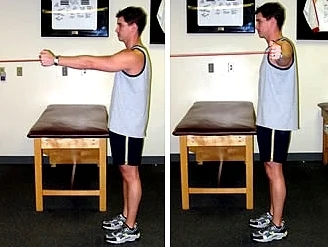
Rowing with a Resistance Band - Using the same set up as before, but this time with the hands held horizontal. Start a rowing motion as shown.

Standing Elevation - Flapping Motion with hand weights - as shown
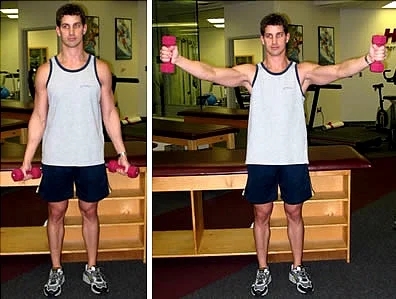
Scapular Stabilization Exercises - as Shown
